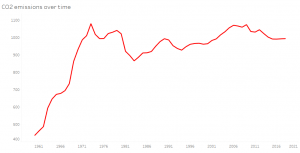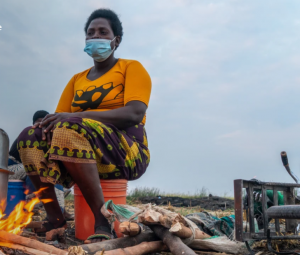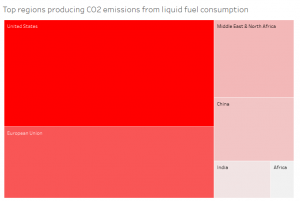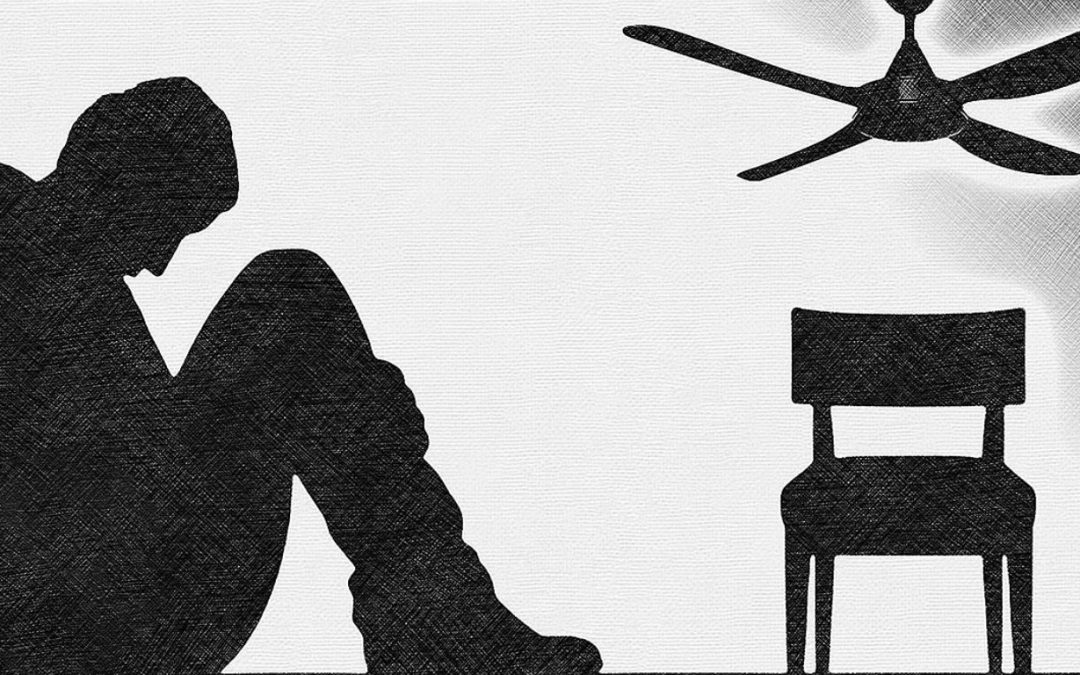
by tba06 | Nov 19, 2022 | Dashboard, Team Project, Visualization
Authors: Tala Abdul Samad, Nour Al Bidewe, Basman Hariri, Sara Sadaka, Aziz Saliby, Jean-Pierre Sakr
Over the past two years, Lebanon has been witnessing compounded crises such as brain drain, poverty, unemployment, and inequality. On October 3rd, we wanted to listen to the factors that affected the Lebanese the most. Borhan, a 60-year-old man living in Beirut, was one of the people we met. We captured a video with him to show the suffering of the Lebanese since the start of the crisis where he comprehensively described the severe living conditions. As we all know, 2019 was a year of transformation for Lebanon, beginning with the October 17th revolution in 2019, following the global pandemic in 2020, and the rise of inflation. Borhan expressed the feelings of most Lebanese, where he identified the problems that we are facing as residents. Many people mentioned that specific sectors have been hit the most, therefore we would like to perform exploratory data analysis and surveys using different datasets to be able to identify inequalities. We are also interested in using a data-driven approach to identify gaps and inequalities that exist in the education, income, and health sectors.
As a result, we have exploited the World Bank’s World Development Indicators and we have identified several indicators which we have used as proxies to measure multidimensional poverty in Lebanon. We chose to have a topic related to the multidimensional poverty index in Lebanon compared to the Arab region. Since the multidimensional poverty index is calculated using three different dimensions, namely education, living conditions, and health, we decided to divide the three different dimensions among us.
Living Conditions:
Housing is a significant indicator of the multidimensional poverty (MDP), and based on ESCWA calculations, the main indicators to assume whether housing is counted as depreciation for a household or not are ‘Overcrowding rate’ – the percentage of the population living in an overcrowded household – ‘Housing type’ i.e. houses, apartments, row houses, townhouses and duplexes, ‘Sanitation quality’ – availability of handwashing facilities, toilet cleanliness.
Historical data related to housing utilities in Lebanon was gathered from the Central Administration of Statistics (CAS), which contains significant indicators to measure MDP such as water, electricity, gas, actual rent, furnishings, household equipment and routine household, and others. Data is shown monthly from December 2007 till September 2022.
This data reported many indicators highlighting the increase in poverty on multiple sides. It is worth reporting that the consumer price index (CPI) Housing Utilities in Lebanon records the highest score this September 2022 (363.3) compared to October 2021 (215.9).
Looking at the nutrition level, food inflation was detected as the cost is more skewed to the right for the year 2021-2022; rising food prices reduce the purchasing power of food consumers. Another devaluation could be mentioned in the transportation sector, as the transportation sub-index of the CPI basket in Lebanon increased by 2339 points in September of 2022 (3,725), compared to August 2021 (1,386); the cost of transportation is significantly increasing, resulting in a limitation to access in the transportation sector.
It is worth mentioning that the CPI in Lebanon has more than doubled over the past year, peaking this September 2022 at a score of 1,611.4 against 714.8 in October 2021, and a higher CPI indicates higher inflation. This eventually leads to adjustments in the cost of living and income, which tends to worsen inequality or poverty as it hits income and savings harder for poorer or middle-income households than for wealthy households.
Healthcare System:
As stated by Joao Martins, MSF Head of Mission in Lebanon, “The crisis in Lebanon has been driven by years of corruption and now we are seeing that this can contribute to the destruction of an entire health system just as effectively as war or a natural disaster”. As a result, it is important to conduct a deep dive analysis on the healthcare system in Lebanon which is a dimension that measures multidimensional poverty.
First we will look at the current health expenditure (%of GDP) which takes into account the public and private health expenditure. By comparing Lebanon to the Arab World, we can notice that the current health expenditure is higher along the mid 2000 with Lebanon having 11% in 2000 while the Arab World having 4%. After that, Lebanon witnessed a decrease and the Arab World an increase reaching a value of 9% and 5%, respectively. The decrease in the expenditure in Lebanon has negatively affected the healthcare system as medication and vaccines are becoming scarce. Looking more closely, we can see in the next graph that the access to immunization has tremendously decreased in Lebanon. On average the access to vaccines (such as DPT, HepB3, and measles) has decreased from 83% (2000) to 67% (2021).
On another hand, we evaluated the demand for private insurance in Lebanon. As we can see, the demand has decreased from 70% (2000) to 45% (2021). This decrease is due to all private insurance companies converting their payment method to fresh U.S. dollars and since the NSSF benefits have diminished due to the economic crisis, most Lebanese people are now left with no proper access to health assistance.
Education:
We also conducted a survey on school and university students to analyze access to online education during the COVID-19 pandemic which was also identified as the new normal.
You can be part of our project by filling this online survey. Your answers are highly valuable to the development of our dashboard since the larger the sample size, the more accurate our results would be.
At a later stage, we would like to present our results to our target audience which are UN agencies, local NGOs, and Lebanese ministries. We got a total of 135 responses from all over Lebanon where the survey was populated via social media platforms. The majority of the respondents were university students or graduates. Most of them were unemployed or employed in a full time position.
We asked the respondents about their evaluation to their online experience; the answers rated their experience as poor or fair. On a scale from 1 being a very bad experience and 5 being a very good experience, most of the respondents rated the effectiveness of online learning as 3. In addition, we asked about the preferred type of education; the majority answered the traditional physical method as the most preferred following the hybrid method as second preferred. These answers make us conclude that the online learning experience was not that good in Lebanon. This might be due to the lack of training from the government and the teachers.
To further explore the facilities that were available to ease the online learning experience, we asked the people about their access to devices, electricity and internet. For the devices, the majority had access to devices that were mainly Mobile phones or laptops. Most of the respondents have access to electricity but not all the time while almost all the respondents have access to internet but the variance changed between access all the time and access but not all the time. Most of the respondents reflected that they couldn’t focus and they weren’t serious about their studies during online learning. Furthermore, on a scale from 1 being not at all to 5 being for sure, we asked the people about their willingness to retake the online experience. The answers varied between 1 and 2 mainly.
Finally, we asked the people about the disadvantages of online learning. Some of the responses include poor network, electricity cuttage, procrastination, weak communication, lack of motivation to study, more distraction, professors are not equipped with the resources, challenging experience for both students and professors. From this survey, we can conclude that Lebanon wasn’t prepared well for such a situation, especially its basic infrastructure which includes bad electricity and network services.
by zainab hodroj | Apr 15, 2022 | Dashboard
Around the world, we’re seeing clear evidence that our climate is changing. Floods, drought, heatwaves, and forest fires have all become more extreme in recent years.


As CO2 emissions in the atmosphere increase climate change increases.
One billion children are at ‘extremely high risk’ of the impacts of the climate crisis – UNICEF.

Over time, CO2 emissions have kept on increasing, and there are many reasons behind it. Between 1960 and 2020, CO2 emissions grew by over 90%, with emissions from liquid fuel consumption, electricity and heat production making up to 80% of CO2 emissions

This increase in CO2 emissions has led to a serious issue leading to Climate change and making life harder for all communities around the world, especially communities who struggle in finding clean water and it has impacted different aspects of their lives.
Every day, fragile water supplies are at even greater risk of disappearing completely. Drought or floods can damage water supplies and spread disease at the other extreme.

Belita in Malawi would agree. She relies on open water sources like Lake Chilwa for her livelihood. But the lake is prone to the whims of changing weather patterns.
“Due to drought last year, I was not able to produce enough food for my family,” she told us.
“However, I was determined to save my life and that of my children by cultivating a small garden.”

Lake Chilwa is the second biggest lake in Malawi.
Belita and her community rely on it for transport, fishing, and doing business.
At some points of the year, the lake suffers from extreme flooding. At other times, it dries up. Some years, the lake evaporates completely, devastating the community.
In 2019, Cyclone Idai struck, scarring the lake and land further. Leaving the community benefiting from the Lake suffering to find clean water, and continue working in their businesses.
“It used to take 25-40 years for natural drying cycles to occur.
“But now, every three to five years there is an extreme recession in Lake Chilwa.
“This is the impact of climate change.”
– Environmental scientist, Professor Sosten Chiotha
Action Needs to be Taken!

As climate change impacts our planet’s health and ecosystems, we all must do our part to reduce its negative effects. One way to help lessen the effect of climate change is to reduce our carbon emissions.
Countries like the United States, European Union, and the Arab World need to take initiative in decreasing their CO2 emissions through:
- Governmental regulations forcing companies to lower their carbon footprint
- Reducing air travel
- Switching to clean energy through solar panels, wind turbines, and geothermal energy
- Initiating projects to help communities affected by climate change and finding innovative ways to lessen the impact of climate change on their lives.
https://dub01.online.tableau.com/#/site/zainabhodroj/workbooks/833439?:origin=card_share_link

by Abed Estwani | Apr 15, 2022 | Visualization
Steve: “I would kill for – I would kill for sex! YES! KILL!”
The Board lights up with “KILL” as the no. 2 answer, the audience in the studio laughed, the audience at home laughed, and the video went viral of yet another successful episode of family feuds. Good job Steve, you are one hell of a host.
 That night, the audience in the studio went home after a good laugh. After all, it is all good, if it is just a joke, right? But guess what, this isn’t a joke. This is a reality that many women face on a daily basis. That’s already horrendous, yet there exist an even harsher and more terrifying reality.
That night, the audience in the studio went home after a good laugh. After all, it is all good, if it is just a joke, right? But guess what, this isn’t a joke. This is a reality that many women face on a daily basis. That’s already horrendous, yet there exist an even harsher and more terrifying reality.
Meet Fadimata,
 a young woman, married at the age of 18, a mother of two, and she spends her day roaming around carrying a basket over her head selling fresh produce to help support her family. She never got the chance to continue her education, but she’s doing her best to survive.
a young woman, married at the age of 18, a mother of two, and she spends her day roaming around carrying a basket over her head selling fresh produce to help support her family. She never got the chance to continue her education, but she’s doing her best to survive.
But once she gets home, that’s when her hell begins.
 She gets beaten up by her husband if she doesn’t service him sexually. Let that sink in. She goes back home… only to get beaten if she refuses to sex her husband.
She gets beaten up by her husband if she doesn’t service him sexually. Let that sink in. She goes back home… only to get beaten if she refuses to sex her husband.
If that wasn’t bad enough, wait for the uppercut.
She believes her husband IS justified for beating her when she refuses sex with him.
Now imagine that is YOU…
Unfortunately, more than 60% of women in Mali believe that a husband is justified to beat his wife if she refuses to have sex with him; quite. Similarly, countries like Guinea, Niger, Burundi, Chad, Senegal, etc… also experienced a relatively high rate of women accepting that notion.
 On the other hand, countries like South Africa, Albania, Dominican Republic, and Colombia had shown that the percentage of women accepting the notion of a husband being justified to beat his wife if she refuses to have sex with him is to be at 1% or less.
On the other hand, countries like South Africa, Albania, Dominican Republic, and Colombia had shown that the percentage of women accepting the notion of a husband being justified to beat his wife if she refuses to have sex with him is to be at 1% or less.
Drilling down into this alarming phenomenon, and trying to understand why such a phenomenon even exists, we discovered yet another factor that might play a significant role in that.
The dropout rate for female students from the educational system (especially at the primary level) is astronomically higher in countries where women believe in the notion compared to the countries where women do not share this notion.
 As such, one way to combat this notion is to heavily invest in the educational sector and facilitate accessibility in order to empower women and break these hellish chains.
As such, one way to combat this notion is to heavily invest in the educational sector and facilitate accessibility in order to empower women and break these hellish chains.
 However, as demonstrated by Burundi, while education might be key, it is not enough. It should be coupled with awareness and empowerment campaigns in order to reinforce the self-esteem and self-worth of these marginalized female groups.
However, as demonstrated by Burundi, while education might be key, it is not enough. It should be coupled with awareness and empowerment campaigns in order to reinforce the self-esteem and self-worth of these marginalized female groups.
Let’s work together to make this world a better place for all of us!!!


by Charles Wakim | Apr 15, 2022 | Visualization
Sustainable development goals are set by the United Nations for countries to reach by 2030. And as you’re getting closer and closer to the deadline, I decided to dig deeper into it and check the WDI dataset to see where we stand right now.
One particular goal I looked after, since it’s the easiest to achieve, is gender equality, the fifth goal set by the UN (SDG 5.5.2).
One way to gauge the progress made by the countries in order to reach these goals was so take a look at women’s employment share in senior and middle management. Precisely in the European Union (EU), a rather advanced community when it comes to human rights.
Surprisingly enough, the EU, a utopia of ours (us, Middle Eastern), is not as perfect as we might think. The birthplace of human rights, the nest of gender equality and the one that found the solution for a better living still struggles in achieving perfect gender equality, especially in high positions. And even though we could always argue they’re doing better than us; they’re still not doing enough!

The EU’s average in women’s share of employment in senior and middle management falls around 30%, far away from the 50% target. Even worse, some countries like Italy have their average around 22% without any considerable increase these last few years.
Fortunately, other countries like Latvia reached records of 45% women employment in middle and high management. Even better, this particular country showed a significant increase in numbers in this area between the year 2009 and 2010 due to some regulations taken at that moment without any huge drop afterwards.
Italy could get some inspiration from the Latvian regulations created in order to increase women’s share and middle and senior management and try and fix their low numbers by applying easy to implement solutions and monitor their effectiveness over time.
Once we finish observing Italy, we could use this pilot experiment to try and generalize the process. Then try to implement it in other countries and turn gender inequality in managerial positions to history.

by Salem G. | Apr 14, 2022 | Dashboard, Visualization
Suicide is something no one wants to talk about, the majority of people who are feeling down don’t openly talk about it. The highest population that is being affected are countries that are surrounding Russia, and in South Africa. There are 800k people commit suicide each year, this is due to many economical issues in these countries. Imagine Karim a husband and a father of 2 living in a country where the basic human needs are neglected. Now Karim is struggling to find a job due to the high unemployment rate, this means he is not able to feed his wife and kids. Imagine being in his place in a country with a 26% unemployment rate. People that are unemployed have a higher chance of commit suicide due their mental health taking a hit this could spiral own a dark hole which is hard to come out off. Unemployment forced 40% of the population to suffer from severe or moderate food insecurity and this is the disruption of food intake or eating pattern due to the lack of money and other resources. Now Karim can’t just feed his family but also can’t get the basic human needs.
All these problems correlate strongly with the Social protection and Labor Programs when these programs are lacking the result were higher suicide mortality rate. These programs help the population in managing risks and protect them from food insecurities through various methods. Poland has a high social program and the results of the suicide mortality rate is significantly lower compared to Lesotho which is the opposite with high suicide rates and low social program . This indicates to lower suicide rates we must increase the aid to the population by offering labor market, unemployment benefits, and other programs. Now Karim can relax and calm down as help is on its way to assist him and other people who are in need.


















